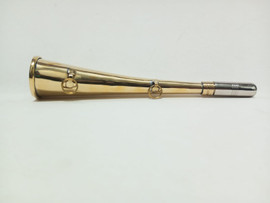The Fascinating World of Fox Hunting Horns: History, Significance, and Modern Usage

Strong 8k brings an ultra-HD IPTV experience to your living room and your pocket.
Fox hunting, a centuries-old tradition, has long been associated with the British countryside, evoking images of riders in red coats, packs of hounds, and the distinctive sound of the genuine fox hunting horn. This horn, an essential element of the hunt, serves both practical and ceremonial purposes. Understanding its history, significance, and modern usage provides insight into the enduring legacy of this controversial sport.
Historical Background
The fox hunting horn, also known as the hunting horn or simply the horn, has its roots in the medieval period. Initially, hunting horns were made from animal horns, such as those of cattle or rams. These primitive instruments were later replaced by more refined versions crafted from metal, primarily brass or copper, which allowed for greater durability and a clearer, louder sound.
The use of the horn in hunting predates its association with fox hunting. Early hunters used horns to communicate during the chase, signalling different phases of the hunt, such as the start, the sighting of the quarry, or the end. As fox hunting became more popular in the 17th and 18th centuries, the hunting horn became a crucial tool for coordinating the complex activities of the hunt, which involved large numbers of participants and hounds.
The Role of the Fox Hunting Horn
The primary function of the fox hunting horn is communication. In the chaos of a hunt, where riders and hounds can be spread over a considerable distance, the horn’s sound carries over great distances, conveying specific messages to the participants. Different notes and sequences, known as "calls" or "blows," are used to convey different messages. For example, a series of short, sharp notes might signal the sighting of the fox, while a longer, more sustained note could indicate the end of the hunt.
Each hunt may have its variations of these calls, but some are standardized and widely recognized. The "Gone Away" call signals that the fox has been seen leaving the cover, while the "Gone to Ground" call indicates that the fox has taken refuge in a burrow. These calls are not just functional; they are also part of the rich tradition and pageantry of fox hunting, adding to the spectacle of the event.
The Craftsmanship of Hunting Horns
The making of fox hunting horns is a craft that combines artistry with functionality. Traditional horns are typically made from brass, a material chosen for its acoustic properties and durability. The process begins with the shaping of the metal into a conical tube, which is then bent into the characteristic circular shape of the hunting horn.
Modern hunting horns can also be made from other materials, including plastics and composite materials, which can offer greater resilience and require less maintenance. However, many enthusiasts prefer traditional brass horns for their aesthetic appeal and the authenticity they bring to the hunt.
Modern Usage and Controversy
While fox hunting has a storied history, it has also become controversial, particularly in the UK. The Hunting Act 2004, which came into effect in England and Wales, banned the hunting of wild mammals with dogs. Despite this, forms of the sport continue, with hunts now following artificial trails laid down beforehand.
In these modern hunts, the fox hunting horn still plays a crucial role. While the purpose of the calls may have shifted slightly – from directing hounds to following a scent trail rather than a live quarry – the horn remains a central part of the event. The tradition and ceremony associated with the horn have helped maintain its significance, even as the sport has evolved.
Cultural Significance
Beyond its practical use, the genuine fox hunting horn with brass cultural significance. It is a symbol of rural heritage and the traditions of the British aristocracy and gentry. The sound of the horn, echoing across the fields, is evocative of a bygone era and the close relationship between humans, animals, and the landscape.
In popular culture, the hunting horn and the hunt itself have been romanticised in literature, art, and film, often depicted as emblematic of a noble pursuit. This romanticisation persists despite the ethical debates surrounding fox hunting, highlighting the enduring appeal of the sport's rituals and symbols.
Conclusion
The modern fox hunting horn is more than just a tool; it is a link to the past, a piece of cultural heritage, and a symbol of the complex relationship between tradition and modernity. Whether viewed as a necessary instrument for a controversial sport or as a historical artefact, the hunting horn's distinctive sound continues to resonate, reminding us of the enduring legacy of fox hunting and the traditions that have shaped it.
Note: IndiBlogHub features both user-submitted and editorial content. We do not verify third-party contributions. Read our Disclaimer and Privacy Policyfor details.





